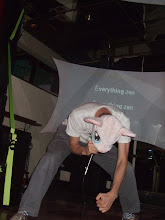Before I present this idea, I'd like to state that I have taken music lessons all my life. First it was piano, then guitar, then drums. My parents paid for the lessons, and I'm glad that they did because a music education is really valuable. Moreover, it's important to have a face-to-face with a human teacher. You get a lot more out of a real-life person than a book or a video cassette.
However, I remember that when I took lessons, I'd be all jazzed-up
during the lesson, but as soon as I got home, all lonely in my room, I'd lose the motivation to practice.
With that said, I want to present my robo-teacher idea. I don't view this as a replacement to a real teacher, but rather a supplement.
It's just a piece of software that interfaces with either your electronic drum kit or your Rock Band drum kit. I'm not a fan of Rock Band, but the potential of that hardware is untapped: What you have there is a drum kit
interfaced with and audio-visual setup (your TV).
Robo Teacher would work like this: you wear the headphones and/or watch the TV screen. It gives you some segment to practice. You play it on your electronic drum kit, and the software recognizes the accuracy of your playing. It advances you to higher levels of complexity as you master each fundamental.
The software would be fun since it would immediately respond to your progress. Just like a video game, you'll advance to higher levels as your skills improve. Only here, the skill is
applicable to real life! That, by the way, is one of the primary things that bugs me about Rock Band. It takes lots of practice to get good at something that essentially is an imitation of real life, but not actually applicable to real life. (Reminds me a lot of my blog about
Nintendo Wii.)
The robo-music teacher will be a lucrative franchise because with each advancing level of mastery, there will be a new piece of software to buy. "Level 2 Intermediate," "Level 3 ..." And different styles of music to fit all tastes, "Master Samba Rhythm in 3 Weeks," "Rock Essentials," "Metal..."
And not to reiterate the obvious, but this would be better than a video game because you'd walk away with real-life skills. Imagine that! You could learn "Merengue Essentials" from a digital tutor, and the next week be on stage playing with a real band.
Back to the idea of a real teacher versus a digital one: In my opinion they are not in competition. A human teacher is better at some things than a digital teacher: A human can explain the concepts, inspire the student and focus the student's skills and abilities. But they can't sit there for hours while you drill some 4 measures over and over again. Eventually you, the student, just have to do the tedious work alone.
I'm a Spanish tutor now. I can go to the kid's house and explain the concepts to them, have conversations in Spanish and help them focus on what to practice. But there comes a time when you have to say, "Just memorize these 55 verbs and their conjugations." I remember when I was struggling to learn to type, my mom got me Mario Teaches Typing. Suddenly something "tedious" became fun. Same thing here, kinda.
